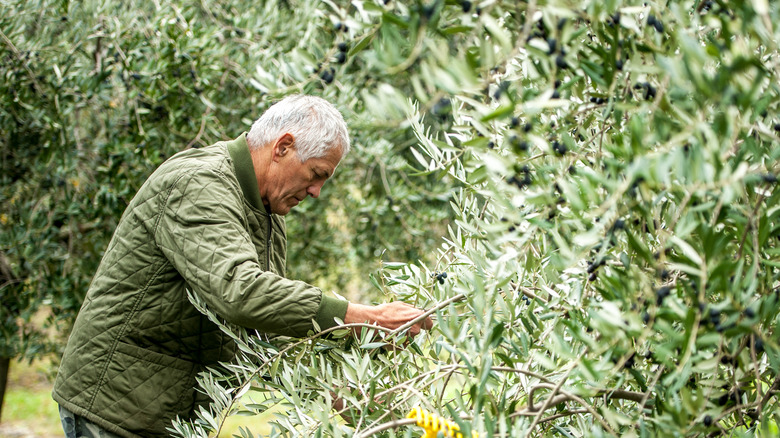The Beautiful Fruit-Bearing Tree That's Actually Invasive
When you think of fruit-bearing trees, you probably picture their beautiful, fragrant blooms or the bountiful harvest they bring to your yard. However, some of these plants have disadvantages that far outweigh their benefits. One such tree is the autumn olive. Autumn olive (Elaeagnus umbellata Thunb) was brought from Asia to the United States in the 1830s and was originally planted to provide food and vegetation for wildlife and to prevent soil erosion. However, what started as a harmless, ornamental plant has become an invasive species throughout the United States.
This tree is able to take root in even the most unfavorable conditions, allowing it to grow quickly. It's also able to spread rapidly thanks to the about 200,000 seeds that are produced annually from just one plant. Autumn olive is also known for pushing out native species by creating too much shade and by producing excess nitrogen in the soil, which can be detrimental to plants that have grown accustomed to low nutrient levels. It's important to know if you have autumn olive in your yard and how to remove it, as it's one of the many invasive plants you should never grow.
How to identify autumn olive
At first glance, autumn olive may seem like just another ornamental shrub or tree, but it has a few defining characteristics that will help you identify it in your yard. It has simple, bright green leaves with an underside that appears silver or white. This multi-stemmed plant can quickly grow up to 20 feet tall and spread to about 30 feet wide. The ashy brown stems also feature small, sharp spines. What's most identifiable about the autumn olive plant, though, are its trumpeted, light yellow flowers that bloom in clusters in the spring. In addition to flowers, the plant also produces bright red berries in the late summer.
You'll likely find autumn olive growing in an area with partial to full sun, as it doesn't grow well in dense shade. As a drought tolerant plant, it's also able to thrive in most moisture and soil conditions, contributing to its invasive nature. Autumn olive grows along the East Coast from Maine to Virginia and west to Wisconsin near roadsides and forests as well as in open fields and clearings.
Autumn olive can easily be confused with Russian olive (Elaeagnus angustifolia), another invasive shrub. Instead of growing eye-catching red berries, the Russian olive produces green berries. Aside from this small difference, the plants are very similar and both must be controlled to avoid their spread.
How to remove autumn olive and stop it from spreading
If you've noticed that you have autumn olive growing in your yard, the next step is to remove it. There are a few ways this can be done. You can remove seedlings or small sprouts by hand, ensuring that the entire plant, including the root, is removed. Not only is it important to remove the autumn olive plant itself, but it's also important to control its spread through seeds. Birds and other wildlife are one of the main ways that the seeds of autumn olive are spread. To prevent animals from ingesting autumn olive berries and then depositing them throughout your yard, it's wise to remove autumn olive before its berries sprout. Further, never prune or burn autumn olive, as this can actually cause the plant to spread further.
For larger, more mature trees, apply a glyphosate herbicide to freshly-cut stumps to eradicate it and prevent it from spreading further. Before applying, though, it's important to understand how certain herbicides may affect other plants surrounding the autumn olive. Glyphosate is a non-selective type of herbicide, meaning you should take great care when applying to ensure you safely remove the invasive species from your yard or garden without harming native plants. Additionally, if you like the look of autumn olive and want to add a similar but native species in your yard, consider planting buffaloberry (Shepherdia canadensis) or wild plum (Prunus americana).


